Captain Cook Snorkel Tour A Complete Guide
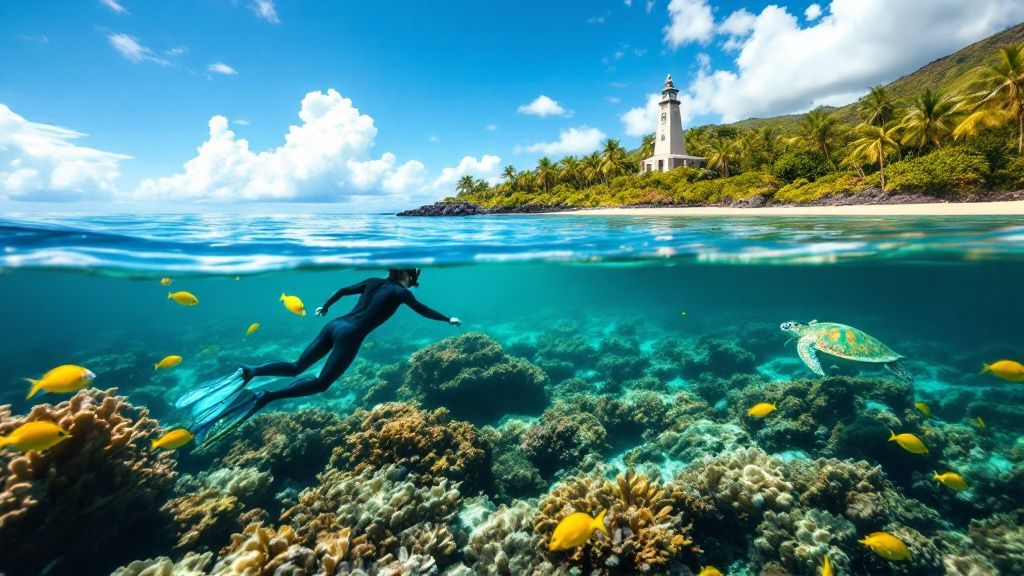
Picture this: you’re floating effortlessly in calm, turquoise water. Below you, a vibrant coral reef pulses with life, and a kaleidoscope of tropical fish swirl all around. That’s the real magic of a Captain Cook snorkel tour, and it's hands-down one of Hawaii's most incredible ocean adventures.
This guide will walk you through everything—from booking the right boat to spotting the coolest fish—so you can make the most of this iconic Big Island experience.
Why Kealakekua Bay Is a Snorkeler's Paradise
A Captain Cook snorkel tour isn't just a quick dip at a pretty beach. It's a full-on journey into a protected marine sanctuary, a place packed with history and absolutely teeming with life. The destination, Kealakekua Bay, is more than just a spot on the map; its unique shape naturally blocks the rough ocean swells.
This protection creates some of the calmest, clearest water you'll ever see, often with visibility stretching over 100 feet. It's like having an IMAX-HD view of a bustling underwater city. Because the bay is a Marine Life Conservation District, its ecosystem is in amazing shape. That’s why taking a guided tour is the best way in; otherwise, you’re looking at a serious hike or a tough kayak paddle to get there.
A Mix of History and Nature
What really makes this trip special is the history. That striking white obelisk you'll see from the water? That's the Captain Cook Monument. It marks the very spot where the British explorer Captain James Cook was killed back in 1779.
Knowing that adds a whole other layer to the experience. You’re not just swimming—you’re floating through a place that's deeply important to Native Hawaiians and a key location in world history. It’s this blend that makes the tour a must-do:
- Amazing Snorkeling: The water is so calm and clear, it's perfect whether you're a total beginner or a seasoned pro.
- Tons of Marine Life: Think healthy coral, colorful fish, sea turtles, and, if you're lucky, a pod of spinner dolphins.
- Fascinating History: You get a direct connection to Hawaii's past and the story of Captain Cook’s final days.
It's not just about what you see under the water; it's about feeling the history of the place. The bay itself tells a story, and the snorkel tour is your ticket to being a part of it for a day.
Coming up, we'll dive into the different kinds of tours you can book, from big catamarans with waterslides to smaller, more personal boats. I’ll help you figure out which one is the perfect fit for your day in this Hawaiian paradise.
How to Choose the Right Captain Cook Snorkel Tour
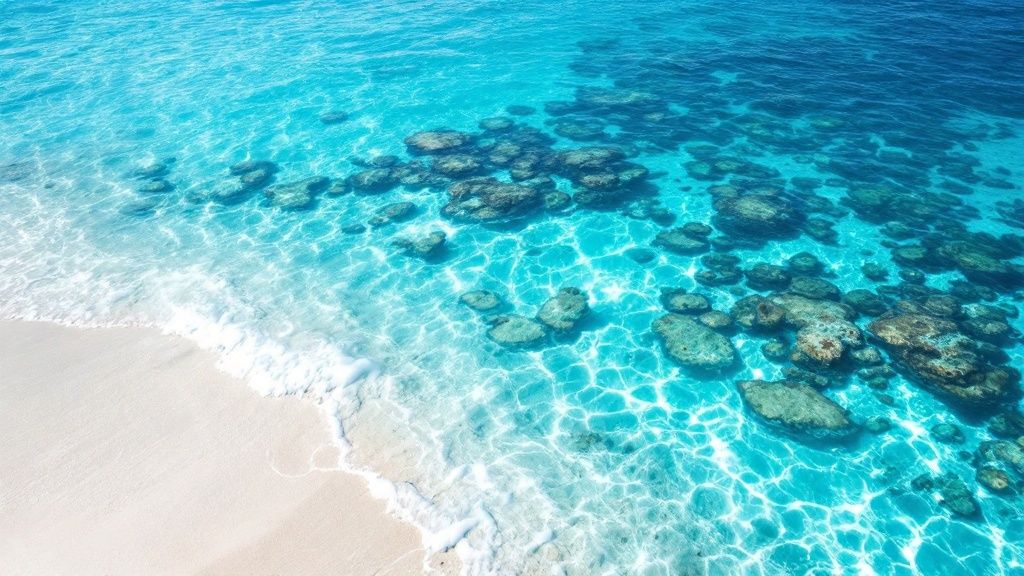
Picking the right Captain Cook snorkel tour can feel a bit overwhelming. You see a bunch of boats online, all headed to the same gorgeous spot. But here's the thing: the boat you choose is going to define your entire day. It's the difference between a floating party and a quiet, personal journey into the heart of the bay.
To find your perfect match, just picture your ideal day on the water. Are you bringing young kids who would go wild for a waterslide off the back of the boat? Or are you a couple hoping for a peaceful morning with a smaller crowd and more time to chat with the guide? Nailing that down is your first step.
Every tour operator creates a different vibe. Think of it like picking a restaurant—some are loud, fun, family-style places, and others are quiet little bistros. Both serve great food, but you're in for a totally different experience.
Decoding Tour Types and Boat Sizes
The size of the tour boat is probably the single biggest factor that will shape your trip. It dictates how many people you'll be with, what amenities are on board, and the whole feel of the day. Your options really boil down to two main types.
Smaller boats, usually for 6 to 12 people, give you a more intimate and adventurous feel. It’s less like a commercial tour and more like you’re out on a friend's boat for the day. With a small group, you get more one-on-one time with the crew, who can share all kinds of cool stories about the bay's history and point out specific fish.
On the other hand, the big catamarans and larger vessels are built for comfort. They can hold 20 to 40 passengers or more and are awesome for families or bigger groups. They often come loaded with features that make the day easier and more fun for everyone.
Think of it this way: A small boat tour is like a guided hike with a naturalist, focused on deep exploration. A large catamaran tour is like an all-inclusive resort day pass, packed with amenities and social energy.
You can see this difference pretty clearly when you look at who's running the tours. Some companies specialize in small-group trips where the snorkeling is the main event. Other well-known operators run big boats with lunch buffets and waterslides, creating a super fun, family-friendly atmosphere that's perfect if you have kids. You can learn more about the different tour options and how they stack up over at Kona Honu Divers.
Comparing Captain Cook Snorkel Tour Operators
To help you decide, let's put the typical tour options side-by-side. Think about what's most important to you—is it the price, how long you're out, or the perks on the boat? This table breaks down what you can generally expect.
| Tour Type | Typical Duration | Group Size | Key Amenities | Average Price Range |
|---|---|---|---|---|
| Small Boat | 3-4 hours | 6-12 people | Basic snacks, drinks, snorkel gear | $$ |
| Large Catamaran | 4-5 hours | 20-40+ people | Lunch, restrooms, waterslides, shade | $$$ |
This makes the trade-offs pretty clear. A smaller tour can be more focused and a bit easier on the wallet, but a bigger boat offers comforts like bathrooms and lunch, which can be a lifesaver on a long day out with the family.
Aligning the Tour with Your Vacation Vision
At the end of the day, the right choice is the one that fits your personal vacation style. Before you click that "book" button, run through a few final questions to make sure you're picking the perfect Captain Cook snorkel tour for your crew.
- Who are you traveling with? A family with toddlers has totally different needs than a group of serious divers.
- What's your main goal? Are you trying to get as much time in the water as possible, learn about marine life, or just chill out on a beautiful boat?
- What's your budget? Prices can vary quite a bit, so figure out what you're comfortable spending per person.
By thinking through these things—your group, your goals, and your budget—you'll see past the generic tour descriptions. You'll be able to pick an experience that doesn't just get you to Kealakekua Bay, but gets you there in a way that creates your perfect day in paradise.
Exploring the Rich History of Kealakekua Bay
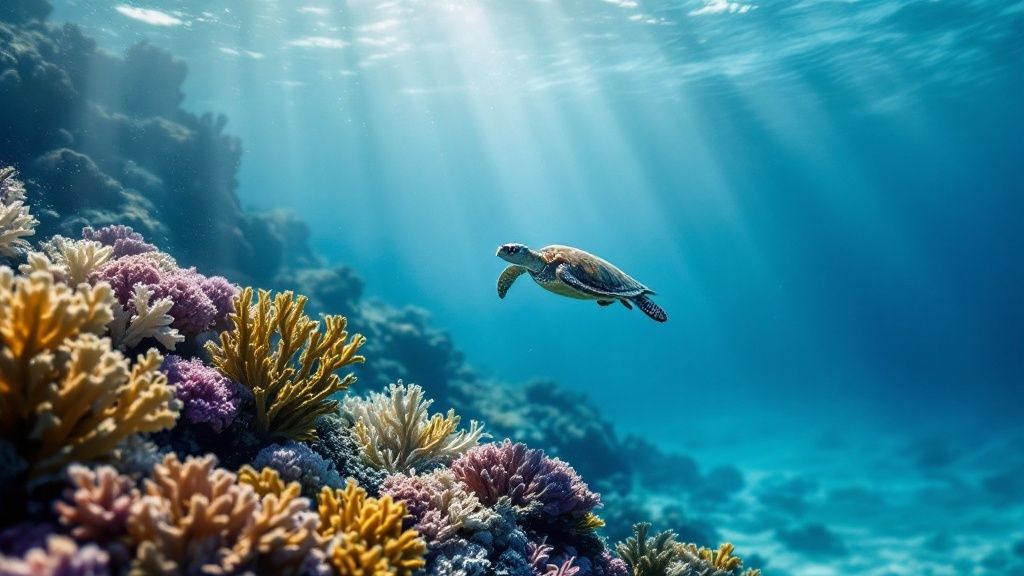
When you glide into the calm, protected waters of Kealakekua Bay, you’re doing more than just arriving at a premier snorkeling spot. You're entering a living history book. This place is so much more than its vibrant coral gardens, and understanding its stories will completely transform your Captain Cook snorkel tour from a fun day on the water into a truly profound experience.
The stories here are layered, just like the volcanic rock that forms the island itself. Long before any Western ships appeared on the horizon, Kealakekua Bay was a place of great importance for Native Hawaiians. Its name, "Kealakekua," actually translates to "the pathway of the gods," which gives you a hint of its sacred status as a center for religious and political life.
The Arrival of Captain Cook
This ancient Hawaiian world collided with the West in 1779 when the British explorer Captain James Cook sailed his ships, the Resolution and the Discovery, into the bay. At first, his arrival was met with awe. The Hawaiians were in the middle of celebrating the festival of Makahiki, and it's thought they may have seen Cook as an earthly form of their god Lono, leading to a brief period of peaceful exchange.
But that initial harmony didn't last. A series of cultural misunderstandings and rising tensions between the British sailors and the Hawaiian people started to build. Things came to a head when a small boat was stolen from one of Cook's ships, which prompted him to try and take a high-ranking chief, Kalaniʻōpuʻu, hostage.
This was a massive insult, and the confrontation that erupted on the shoreline was swift and fatal. On February 14, 1779, Captain Cook was killed in the skirmish, forever linking his name to this sacred Hawaiian bay.
The Iconic White Monument
Today, a stark white obelisk stands on the shore, easily visible from every tour boat in the bay. This is the Captain Cook Monument, a 30-foot structure put up by the British to mark the spot where their famed explorer died. In a strange twist of history, the small piece of land it sits on was actually deeded to the United Kingdom, so you’re technically looking at a tiny slice of British territory right here in Hawaii.
The monument itself is a huge draw for visitors, but its presence on land that is deeply sacred to Native Hawaiians highlights the complex and often painful colonial history of the islands. It makes your visit a real moment for reflection.
The monument serves as a powerful symbol of the bay's dual history. It commemorates a pivotal moment in Western exploration while standing on ground that holds centuries of indigenous spiritual importance.
A Sacred Place for Hawaiians
While the monument is the most obvious landmark, it’s crucial to remember that the entire bay is a wahi pana—a legendary and storied place—for Native Hawaiians. The towering cliffs that frame the bay, known as Pali Kapu O Keōua, contain ancient burial caves of Hawaiian royalty, making the whole area profoundly sacred.
This deep cultural reverence is a key reason why the bay is a protected Marine Life Conservation District. The rules aren't just about protecting the fish and coral; they are about preserving a place of immense cultural heritage.
As you snorkel, take a moment to look back at the shoreline and the massive cliffs. You're swimming in waters that have witnessed royal ceremonies, the birth of modern Hawaiian history, and centuries of daily life. Understanding this context adds a rich, meaningful layer to every school of fish you see. Your Captain Cook snorkel tour is a unique chance to connect with these powerful currents of history that flow just beneath the surface.
To better prepare for your journey into this historic bay, check out our detailed guide to the Kealakekua Bay snorkeling tour.
The Incredible Marine Life You'll See
Slipping into the calm, clear waters of Kealakekua Bay is like dropping into a completely different world. The real magic of a Captain Cook snorkel tour isn’t just the monument or the gorgeous coastline; it’s the bustling underwater city that explodes with life right in front of your mask. This isn't just about seeing a few fish—it's about becoming a temporary resident in one of Hawaii's most vibrant marine sanctuaries.
The second your face hits the water, you’re greeted by a dazzling show of color and movement. The water here is so incredibly clear, often with visibility over 100 feet, that you can see the entire reef ecosystem spread out below you like a living, breathing map.
A Symphony of Color and Coral
Your first impression will likely be the sheer number of fish. Imagine swimming through a golden cloud—that’s what it feels like when you stumble upon a massive school of Yellow Tang. They are one of the bay's most iconic residents, and their bright, sunny color creates a crazy contrast against the deep blue water.
As you just float along, you'll start to pick out the incredible diversity that makes this bay so special. It's a true underwater metropolis.
- Ornate Butterflyfish: These elegant fish flit around in pairs, almost like they’re tending to the coral gardens with their delicate patterns and graceful moves.
- Parrotfish (Uhu): You might hear them before you see them—a faint scraping sound. They use their beak-like mouths to nibble algae off the coral, which is a super important job that keeps the whole reef healthy.
- Humuhumunukunukuāpuaʻa: Don't worry, you don't have to say it! Just look for Hawaii's state fish with its unique, angular body darting in and out of rocky crevices.
This rich variety isn't an accident. Because the bay is a protected Marine Life Conservation District, the ecosystem is allowed to thrive without much human interference. The result is a healthy, densely packed reef that is an absolute joy to explore.
Gentle Giants and Graceful Gliders
While the smaller reef fish put on a constant show, it's the bigger encounters that usually stick with you. Keep an eye on the sandy bottom and along the deeper drop-offs of the reef; that’s where you might spot some of the bay's most majestic locals.
The most hoped-for sighting for many is the Hawaiian Green Sea Turtle, or honu. Seeing one of these ancient mariners glide effortlessly through the water is a truly breathtaking moment. They move with a slow, gentle grace that just commands respect. It’s critical to give them plenty of space and never, ever touch them, letting them go about their business in peace.
The honu are more than just wildlife; they are considered sacred ʻaumākua, or ancestral spirits, in Hawaiian culture. Watching them with quiet reverence adds a much deeper meaning to your snorkel adventure.
Unexpected Visitors and Playful Escorts
The magic of your Captain Cook snorkel tour isn't always just below the waves. As your boat heads into or out of the bay, you might get a special escort from a pod of Hawaiian spinner dolphins (naiʻa).
These acrobatic mammals are famous for their incredible aerial shows, leaping and spinning clean out of the air. Seeing them play in the boat's wake is an awesome bonus that connects the underwater world to the wide-open ocean. Just remember, federal law requires boats to stay at least 50 yards away from spinner dolphins to protect them, so your crew will make sure you’re observing from a safe and respectful distance.
From the tiniest, brightly colored fish zipping through coral to the serene glide of a sea turtle, Kealakekua Bay offers a wildlife experience you won’t forget. Knowing what to look for can turn a simple swim into a fascinating adventure, connecting you straight to the vibrant heart of Hawaii's ocean world.
Your Essential Packing and Preparation Checklist
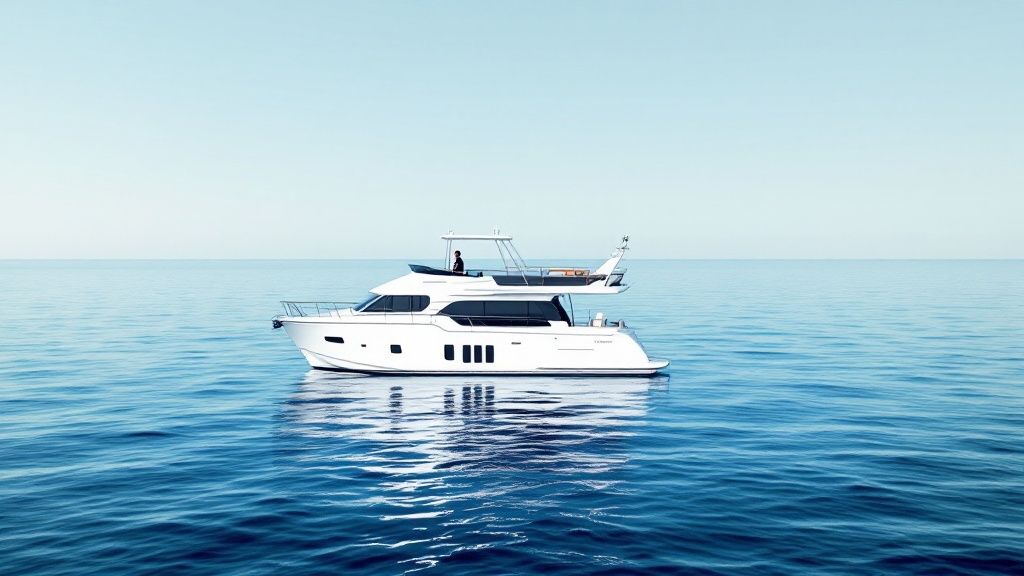
A little bit of prep work can make all the difference between a good day and a great day on your Captain Cook snorkel tour. While we handle the big stuff like the boat and the snorkel gear, there are a few personal items you can bring along that will seriously upgrade your experience. When you pack smart, you can just kick back, relax, and soak it all in.
This goes beyond just remembering to wear your swimsuit. We're talking about the little details that add up to a huge impact—things like sun protection, comfort on the boat, and capturing those incredible underwater moments.
Sun Protection The Right Way
Don't underestimate the Hawaiian sun. It's intense, and when it reflects off the water, it's even stronger. Protecting your skin is absolutely essential, but how you do it is just as important, especially in a pristine marine sanctuary like Kealakekua Bay.
The single most important thing to pack is reef-safe sunscreen. The chemicals in traditional sunscreens, like oxybenzone and octinoxate, are known to bleach coral and harm the delicate ecosystem. Hawaii has even banned sunscreens with these ingredients, so you'll want a mineral-based one with zinc oxide or titanium dioxide.
Want to take your sun protection to the next level? Here are a few pro moves:
- A Long-Sleeved Rash Guard: This is the secret weapon of experienced snorkelers. A rash guard gives you bulletproof UV protection for your back and arms—the parts most exposed to the sun—and means you use way less sunscreen.
- A Wide-Brimmed Hat: A lifesaver on the boat ride. A good hat keeps the sun off your face, neck, and scalp.
- Polarized Sunglasses: These are a game-changer. Not only do they protect your eyes, but they also cut the glare on the water's surface, making it much easier to spot dolphins or other marine life from the boat.
Packing for a snorkel tour is like preparing for a mini-expedition. You want to be ready for the environment you're entering—both for your own comfort and for the health of the reef you've come to admire.
Gear for Comfort and Memories
Beyond just shielding yourself from the sun, a few other items will boost your comfort and help you capture the day's magic. If you want a full deep-dive, check out our complete guide to https://konasnorkeltrips.com/blog/gear-for-snorkeling-on-the-big-island-hawaii/.
And of course, you'll need a good beach towel. If you're wondering what size to get, this a comprehensive guide to beach towel sizes is a surprisingly helpful resource.
Here’s a quick list of other things to toss in your bag:
- Underwater Camera: You're going to want proof of the incredible coral and fish you see. Whether it's a GoPro or a waterproof phone case, just don't forget a float strap!
- Dry Bag: This is one of those things you'll be so glad you brought. A small dry bag keeps your phone, wallet, and car keys completely safe and dry from any splashes on the boat.
- Motion Sickness Remedy: If you even think you might get seasick, it's better to be safe than sorry. Take your preferred remedy before you get on the boat so it has time to kick in.
- Reusable Water Bottle: Staying hydrated is key. Most tours have water, but bringing your own reusable bottle is an easy way to be eco-friendly and make sure you have plenty to drink.
Safety Tips and Responsible Snorkeling Practices
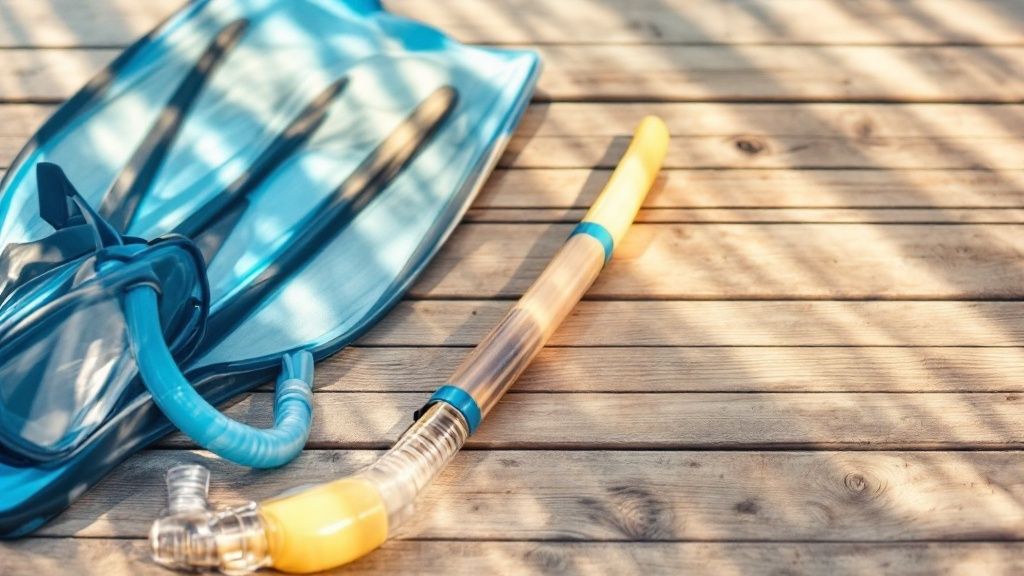
Stepping into a protected marine sanctuary like Kealakekua Bay is a real privilege. It also comes with a shared responsibility to keep this incredible place safe and pristine for everyone who comes after us.
Following a few key guidelines on your captain cook snorkel tour isn't just about your own safety—it's about protecting the fragile underwater world you've come all this way to see. Think of yourself as a respectful guest in a magnificent, living home.
Your tour crew is going to give you a thorough safety briefing, and it’s super important to listen up. They’re the experts on the day’s specific conditions and will give you instructions tailored to keep everyone out of harm's way. The number one rule? Always snorkel with a buddy; never go off on your own.
Knowing your physical limits is also a big deal. Snorkeling is a blast, but it's still a physical activity. Make sure you stay hydrated by drinking plenty of water throughout the tour. It's also a good idea to know how to prevent muscle cramps so you can fully enjoy your time in the water without any discomfort.
Your Role as an Ocean Steward
Beyond personal safety, being a responsible snorkeler really boils down to a simple philosophy: look, but don't touch. That beautiful coral reef is a delicate, living organism. A single touch from a hand or even a fin can cause serious, lasting damage.
This same rule applies to all the amazing marine life you’ll see. It's incredibly tempting to get close to a graceful sea turtle (honu) or a pod of playful dolphins, but you have to keep a respectful distance.
Remember these key rules:
- Never Touch the Coral: The oils and bacteria on your skin can harm or even kill the fragile coral polyps.
- Give Wildlife Space: Watch the animals from a distance. Let them move freely and behave naturally without feeling cornered or threatened.
- Do Not Feed the Fish: Tossing them human food messes with their natural diet and behaviors, which can throw the entire ecosystem out of whack.
Your interaction with the bay should be like that of a wildlife photographer in the Serengeti—observe, appreciate, and leave no trace. Your goal is to witness the magic without altering it in any way.
Protecting the Reef Before You Even Get Wet
One of the biggest impacts you can have starts before you even dip a toe in the ocean, and it comes down to your sunscreen. Many traditional sunscreens contain chemicals like oxybenzone and octinoxate, which are known toxins for coral reefs and have actually been banned here in Hawaii.
Always, always choose a reef-safe, mineral-based sunscreen that uses zinc oxide or titanium dioxide as its active ingredient. This one simple choice actively helps protect the vibrant ecosystem you’ve traveled so far to experience.
By following these simple but powerful guidelines, you ensure that the beauty of Kealakekua Bay remains for generations of future snorkelers to enjoy. For a deeper dive into staying safe in the water, check out these essential https://konasnorkeltrips.com/blog/snorkeling-safety-tips/ to feel even more prepared for your adventure.
Answering Your Questions About the Captain Cook Snorkel Tour
Even with a plan in hand, a few questions always seem to pop up before hitting that "book now" button. Getting those last-minute details sorted out is the key to going from feeling prepared to feeling truly excited.
We've heard just about every question there is, from worries about swimming skills to the practicalities of being on a boat for a few hours. Let's clear those up so you can look forward to your day on the water with total confidence.
Do I Need to Be a Strong Swimmer?
Not at all. While knowing how to swim is helpful, you definitely don’t need to be a pro to have an incredible time in Kealakekua Bay. The bay is naturally sheltered, and the water is famously calm, making it a fantastic and low-stress spot even for total beginners.
Every reputable tour company is set up to make sure everyone feels safe and comfortable in the water.
- You'll have flotation support. Life vests, pool noodles, and other floaty toys are standard issue. They do all the work so you can just relax on the surface and enjoy the view below.
- The crew gives great instructions. Before anyone even dips a toe in the water, you'll get a full rundown on safety and how to use the snorkel gear properly.
- Guides are always there to help. If you're feeling a bit nervous, just let the crew know. That's what they're there for! They're trained to help you get comfortable and can offer tips to make sure you have a great time.
What's the Best Time of Year for This Tour?
Honestly, there’s no bad time to snorkel Kealakekua Bay—it's amazing all year round. That said, different seasons offer slightly different perks, so you can pick what works best for you.
For the calmest, clearest, most glass-like water you can imagine, the summer months from May to September are tough to beat. The weather is typically super stable, which translates to incredibly peaceful conditions in the bay.
On the other hand, visiting in the winter, from December to March, offers a truly spectacular bonus. This is humpback whale season in Hawaii, and you have a solid chance of seeing these giants breach and play during the boat ride to and from the monument.
No matter when you go, we almost always recommend a morning tour. The ocean is usually much calmer, and you'll beat the afternoon crowds that tend to gather at the monument.
Are There Restrooms on the Boats?
Yes, that’s a great and very practical question! Nearly all motorized boats heading out for a captain cook snorkel tour will have an onboard marine restroom (called a "head" on a boat). They vary in size, but having one available is a major convenience.
Most tour boats are also kitted out with other comforts. You can expect a freshwater shower to rinse off the salt after your swim, plenty of shade to take a break from the sun, and easy-to-use ladders to get back aboard. Snacks and drinks are pretty much a given, too. Just remember that smaller, non-motorized trips, like a kayak tour, won't have these facilities.
Ready to dive into this historical and ecological wonderland? Kona Snorkel Trips offers expertly guided tours that prioritize your safety, comfort, and connection to the magic of Kealakekua Bay. Book your unforgettable adventure with us today!
